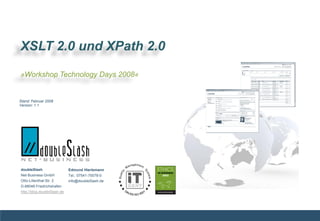
Neues von XSLT 2.0 und XPath 2.0
- 1. XSLT 2.0 und XPath 2.0 »Workshop Technology Days 2008« Stand: Februar 2008 Version: 1.1 doubleSlash Edmund Hierlemann Net-Business GmbH Tel.: 07541-70078-0 Otto-Lilienthal-Str. 2 info@doubleSlash.de D-88046 Friedrichshafen http://blog.doubleSlash.de Folie 1
- 2. »Überblick und Inhalt« Neuerungen zu den Versionen 2.0 > Warum XSLT 2.0 und XPath 2.0? > XSLT 2.0 Features und Syntax. Beispiel-Code. > XPath 2.0 Features und Syntax. Beispiele-Code. > Welche XSLT-Prozessoren existieren? > Fragen? Folie 2
- 3. »Warum XSLT 2.0 und XPath 2.0« XSLT 1.0 > Spezifikationen 1.0 ist über 8 Jahre alt. > Verarbeitung erfolgt immer über Trees (RTFs). > Rekursive Aufrufe als Workaround für Schleifen. > Funktionen mit Rückgabe nicht möglich. > … Folie 3
- 4. »Warum XSLT 2.0 und XPath 2.0« XPath 1.0 >• Spezifikation ist über 8 Jahre alt. >• Typsicherheit. >• Keine Schleifen in XPath möglich. >• Keine if-then-else Möglichkeit in XPath. >• Stark eingeschränkte Anzahl an Funktionen (Search-replace,…) >• …. EXSLT bietet Workaround-Packages an. Folie 4
- 5. »XSLT 2.0 und XPath 2.0« ...da war doch noch was XSLT 2.0 und XPath 2.0 löst viele Probleme… …aber nicht alle. Folie 5
- 6. »XSLT 2.0 und XPath 2.0« Features und Syntax Beispiele gefällig? Folie 6
- 7. »XSLT 2.0« Sequenzen anstelle der RTF (result tree <xsl:variable name=quot;sequencequot; fragments) werden sequenzen erstellt select=quot;(1,2,3,4,5,6,1,1,2)quot;/> Listen aller möglichen typen Distinct direkte Erzeugung mit (...) <xsl:value-of select=quot;distinct- values($sequence)quot;/> <xsl:value-of select=quot;(1,2,3,4,5,6)quot;/> Reverse <xsl:value-of select=quot;reverse($sequence)quot;/> Separator RTF <xsl:value-of <xsl:value-of select=quot;(1,2,3,4,5,6)quot; select=quot;/personnel/person/name/givenquot;/> separator=quot;, quot;/> bei value-of select werden aufgrund der Result-Sequenzen jetzt nicht nur der erste, sondern alle knoten gefunden. Folie 7
- 8. »XSLT 2.0« Datentypen string Datentypen sicherstellen double <xsl:variable name=quot;test” as=quot;xs:integerquot;>12</xsl:variable> integer <xsl:value-of select=quot;$test instance of xs:integerquot;/> Boolean aber auch: dateTime gDay gMonth anyURI ... uvm. Folie 8
- 9. »XSLT 2.0« Funktionen <!-- function addierer --> <xsl:function name=quot;a:addiererquot;> <!-- Datentyp-Unterstützung --> <xsl:param name=quot;numberquot; as=quot;xs:integerquot;/> <xsl:param name=quot;number2quot; as=quot;xs:integerquot;/> <xsl:value-of select=quot;$number + $number2quot;/> </xsl:function> Folie 9
- 10. »XSLT 2.0« Gruppen <xsl:function name=quot;a:groupquot;> <xsl:param name=quot;contextquot;></xsl:param> <xsl:for-each-group select=quot;$context/personquot; group-by=quot;originquot;> <xsl:sort select=quot;current-grouping-key()quot; order=quot;descendingquot; /> Origin: <xsl:value-of select=quot;current-grouping-key()quot;/><br/> <xsl:for-each select=quot;current-group()quot; > <xsl:value-of select=quot;name/givenquot;/><xsl:text> </xsl:text><xsl:value-of select=quot;name/familyquot;/> <xsl:if test=quot;position() != last()quot;>,</xsl:if> </xsl:for-each> <br/><br/> </xsl:for-each-group> </xsl:function> Folie 10
- 11. »XSLT 2.0« Analyze String mit Regexp Unterstützung <xsl:template match=quot;commentquot;> <xsl:analyze-string select=quot;.quot; regex=quot;S.*quot; flags=quot;mquot;> <xsl:matching-substring> <b><xsl:value-of select=quot;.quot; /></b><br/> </xsl:matching-substring> </xsl:analyze-string> </xsl:template> Folie 11
- 12. »XPath 2.0« to-Operator <xsl:value-of select=quot;1 to 6quot;/> keine rekursionen mehr <xsl:for-each select=quot;personnel/personquot;> <xsl:value-of select=quot;name/givenquot;/><xsl:text> </xsl:text><xsl:value-of select=quot;name/familyquot;/>: Importance factor: <xsl:for-each select=quot;(1 to count(email))quot;> * </xsl:for-each> <br/> </xsl:for-each> Folie 12
- 13. »XPath 2.0« Schleife und Bedingung Schleife -> spart rekursive aufrufe <xsl:value-of select=quot;for $i in (1 to 6) return $i*2[$i > 2]quot;/> If then else -> spart choose when <xsl:variable name=quot;testquot; as=quot;xs:integerquot;>100</xsl:variable> <xsl:value-of select=quot;if ($test ge 100) then 'gross' else 'klein'quot;/> Folie 13
- 14. »XPath 2.0« Suche und Datumsfunktionen search-replace <xsl:variable name=quot;testquot; as=quot;xs:stringquot;>doubleSlash ist super super Super toll.</xsl:variable> <xsl:value-of select=quot;replace($test,'super','ganz')quot;/> mit regexp <xsl:value-of select=quot;replace($test,'W','<br>')quot; disable-output- escaping=quot;yesquot;/> Datumsfunktionen <xsl:variable name=quot;heutequot; select=quot;current-date()quot; as=quot;xs:datequot;/> normal <xsl:value-of select=quot;$heutequot;/> formatiert <xsl:value-of select=quot;format-date($heute,'[D01].[M01].[Y0001]')quot;/> Folie 14
- 15. »XSLT 2.0 und XPath 2.0« Wann kann ich das jetzt nutzen? Folgende XSLT Prozessoren unterstützen die 2.0 Features bislang: Saxon 9b. Altova XML 2008. Keine konkreten Angaben, ob und wann 2.0 eingeführt wird bei: Xalan Microsoft MSXML (.NET) Folie 15
- 16. »XSLT 2.0 und XPath 2.0« Referenzen > Thomas Meinike http://www.iks.hs-merseburg.de/~meinike/ > D. Pawson http://www.dpawson.co.uk/xsl/rev2/rev2.html > Jeni Tennison http://www.jenitennison.com/xslt/ > W3C http://www.w3.org/TR/xslt20/ http://www.w3.org/TR/xpath20/ Folie 16
- 17. Vielen Dank! Für mehr Informationen und weitere Fragen: »Kontaktiern Sie uns unter 07541-70078-0 oder info@doubleSlash.de« doubleSlash Edmund Hierlemann Net-Business GmbH Tel.: 07541-70078-0 Otto-Lilienthal-Str. 2 info@doubleSlash.de D-88046 Friedrichshafen http://blog.doubleSlash.de Folie 17
